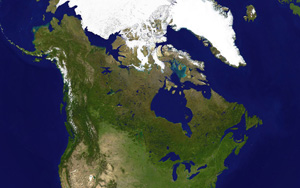FPAC Explains Canada's Forests and Natural Cycles
![]() Print this Article | Send to Colleague
Print this Article | Send to Colleague
The Forest Products Association of Canada (FPAC), Ottawa, Ont., Canada, notes that it and its members understand and embrace the value and importance of managing Canada's forests responsibly. Canada, FPAC points out, has the second largest forest cover in the world, and by law all harvested areas must be regenerated. "We harvest much less than 1% of the forests annually, and can proudly boast that Canada retains 90% of its original forest cover," the association says.
A recent World Resource Institute (WRI) report indicates that forest fires have increased in Canada's boreal forest, which puts Canada second on a global list for tree cover loss in 2013. FPAC, however, notes that it is important to define what WRI means by tree cover loss. The distinction between natural cycles and man-made land use changes are necessary considerations when calculating tree loss.
 Permanent forest loss from urbanization and agriculture expansion is vastly different from temporary tree loss caused by harvesting or natural occurrences like forest fires and pest infestations where trees regrow, according to FPAC. Forecasts using climate change scenarios suggest that fire and pest activity will increase across much of Canada's forests, is points out, adding that the forest products industry continues to collaborate with governments, academics, and other stakeholders on climate change adaptation and mitigation strategies.
Permanent forest loss from urbanization and agriculture expansion is vastly different from temporary tree loss caused by harvesting or natural occurrences like forest fires and pest infestations where trees regrow, according to FPAC. Forecasts using climate change scenarios suggest that fire and pest activity will increase across much of Canada's forests, is points out, adding that the forest products industry continues to collaborate with governments, academics, and other stakeholders on climate change adaptation and mitigation strategies."Canada is a world leader in sustainable forest management practices, and the forest products industry is doing more every day to improve its environmental footprint," says FPAC President and CEO David Lindsay. "Canadians can be proud of our careful management of our renewable forest resources. Even with our already strong green environmental credentials, the forest products industry has pledged under Vision2020 to do more and improve our environmental footprint by another 35% by the end of the decade."
Canada has 163 million hectares or 43% of the world's certified forests, four times more than any other country, FPAC says. Certified Forests are independently assessed, giving assurance that they follow sustainable forest management practices. A Yale University study also says that Canadian forest management practices are among the most stringent in the world, the association adds.
"In Canada 100% of harvested areas are regrown by law and natural disturbances such as forest fires and infestations are part of a natural cycle," Lindsay explained. "In fact, some trees species in the boreal forest depend on fire to regenerate so we need to be clear when discussing the difference between temporary loss and permanent loss of forest cover. Our industry wants to work with governments and environmental groups to ensure a healthy and sustainable forest for Canada."
FPAC provides a voice for Canada's wood, pulp, and paper producers nationally and internationally in government, trade, and environmental affairs. The $58-billion-a-year forest products industry represents 2% of Canada's GDP and is one of Canada's largest employers, operating in hundreds of communities and providing 235,000 direct jobs across the country.


